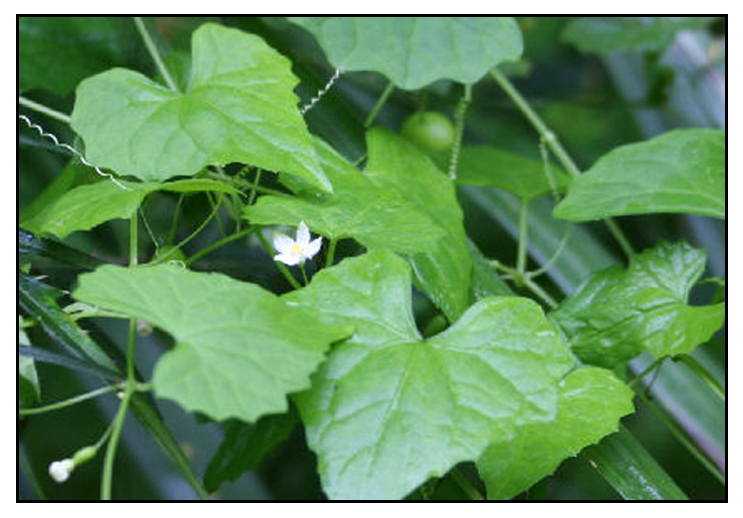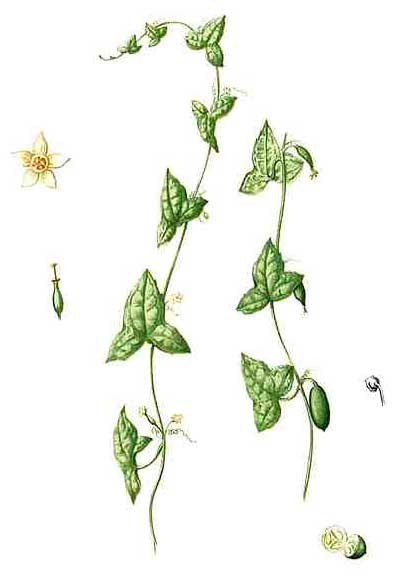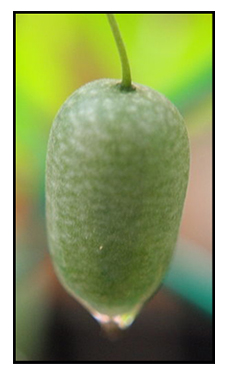
Family • Cucurbitaceae
Melon-daga
Zehneria japonica (Thunb.) H.Y.Liu
MOUSE CUCUMBER
Ye shao gua
| Scientific names | Common names |
| Bryonia japonica Thunb. | Melon-daga (Tag.) |
| Cucumis luzonicus Blanco | Timun-ambau (Sul.) |
| Melothria argyi H. Lév. | Simonkaram (Iv.) |
| Melothria formosana Hayata | Indian zehneria (Engl.) |
| Melothria japonica (Thunb.) Maxim. ex Cogn. | Japanese wild cucumber (Engl.) |
| Melothria japonica var. major Cogn. | Mouse cucumber (Engl.) |
| Melothria leucocarpa var. rubella Gagnep. | |
| Melothria regelii Naudin | |
| Neoachmandra japonica (Thunb.) W.J.de Wilde & Duyfjes | |
| Zehneria formosana (Hayata) S.S.Ying | |
| Zehneria japonica (Thunb.) H.Y.Liu | |
| Melon-daga is a common name shared by (1) Tricosanthes cucumerina, melon-melonan, tabubok, and (2) Melothria indica, melon-daga. | |
| Zehneria japonica (Thunb.) H.Y. Liu is an accepted. KEW: Plants of the World Online | |
| Some compilations Zehneria indica (Loureiro) as a synonym. | |
| Other vernacular names |
| BANGLADESH: Kabu noyea, Ann joy jika, Lui hui oam, Tarani, Yoria sock. |
| CHINESE: Ma die er, Ma jiao er, Ye shao gua, Lao shu la dong gua. |
| INDIA: Chiminphang (Rava). |
| RUSSIAN: Melotriia indijskaia, Zheneria indijskaia. |
| THAI: Tam lueng tua phu |
| VIETNAMESE: D[uwj]a chu[ooj]t d[aj]i, Ch[uf]m th[awr]ng, Hoa b[as]t, D[aa]y p[oj]p. |
Botany Distribution Constituents Properties Availability |
© Godofredo U. Stuart Jr., M.D. / StuartXchange |
Updated November 2022 / August 2018 / December 2015
![]()
 |
PHOTOS / ILLUSTRATIONS |
| IMAGE SOURCE: PHOTOGRAPH / Leaves and flowers of Zehneria japonica / File:Zehneria japonica2SHSU.jpg / SHU SUEHIRO / CC BY 3.0 / Wikimedia Commons |
| OTHER IMAGE SOURCE: ILLUSTRATION / File:Zehneria indica Blanco2.365.jpg / Flora de Filipinas / 1880 - 1883 / Francisco Manuel Blanco (O.S.A)/ Public Domain / Modifications by Carol Spears / Wikimedia Commons |
| OTHER IMAGE SOURCE: Phtograph / Closeup of Fruit / File:BuahTimunTikus.jpg/ Tu7uh / CC BY 3.0 / Wikimedia Commons |
Additional
Sources and Suggested Readings |
• |
DOI: It is not uncommon for links on studies/sources to change. Copying and pasting the information on the search window or using the DOI (if available) will often redirect to the new link page. (Citing and Using a (DOI) Digital Object Identifier) |
| Â Â Â Â Â Â Â Â Â Â Â Â Â Â Â Â Â Â Â Â Â Â Â Â Â Â Â Â Â Â List of Understudied Philippine Medicinal Plants |
• |
 |
• |


 Gen info
Gen info Parts used
Parts used